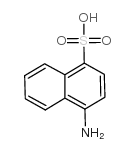Naphthionic acid

Naphthionic acid structure
|
Common Name | Naphthionic acid | ||
|---|---|---|---|---|
| CAS Number | 84-86-6 | Molecular Weight | 223.24800 | |
| Density | 1.67 | Boiling Point | 434ºC | |
| Molecular Formula | C10H9NO3S | Melting Point | ≥300 °C(lit.) | |
| MSDS | Chinese USA | Flash Point | N/A | |
| Symbol |

GHS05 |
Signal Word | Danger | |
|
Identification of [14C]carmoisine metabolites in bacterial suspension of rat faeces.
Food Addit. Contam. 7(1) , 1-7, (1990) An in vitro system consisting of a bacterial suspension of human or rat faecal microflora brought about the biological reduction of the red azo dye [14C]carmoisine to 1-naphthyl-amine-4-sulphonic acid (NA) and 2-amino-1-naphthol-4-sulphonic acid (ANA). These ... |
|
|
Synthetic organic food colouring agents and their degraded products: effects on human and rat cholinesterases.
Br. J. Biomed. Sci. 61(3) , 128-32, (2004) Most synthetic coloured additives are carcinogenic; teratogenic and cause allergic reactions. In this study, the effects of synthetic azo dyes (sunset yellow FCF and carmoisine), as well as their degraded products (sulphanilic acid and naphthionic acid), on b... |
|
|
Regiospecific O-methylation of naphthoic acids catalyzed by NcsB1, an O-methyltransferase involved in the biosynthesis of the enediyne antitumor antibiotic neocarzinostatin.
J. Biol. Chem. 283(21) , 14694-702, (2008) Neocarzinostatin, a clinical anticancer drug, is the archetypal member of the chromoprotein family of enediyne antitumor antibiotics that are composed of a nonprotein chromophore and an apoprotein. The neocarzinostatin chromophore consists of a nine-membered ... |
|
|
Charge-remote fragmentation of peptides derivatized with 4-aminonaphthalenesulphonic acid.
Rapid Commun. Mass Spectrom. 8(10) , 797-803, (1994) A series of small peptides has been studied by negative-ion fast-atom bombardment mass spectrometry with collision-induced dissociation. It has been found that by derivatizing peptides with 4-aminonaphthalenesulphonic acid in a peptide linkage at the C-termin... |
|
|
Circulating naphthionic acid in nonpregnant and pregnant rats after feeding amaranth.
Toxicol. Appl. Pharmacol. 54(2) , 276-84, (1980)
|
|
|
Degradation kinetics of 4-amino naphthalene-1-sulfonic acid by a biofilm-forming bacterial consortium under carbon and nitrogen limitations.
J. Ind. Microbiol. Biotechnol. 39(8) , 1169-77, (2012) By decolorization of azo dyes, caused by reductive cleavage of the azo linkage, toxic or recalcitrant amines are generated. The present study deals with the effect of the inflowing medium composition (C:N ratio) on the kinetic behavior of a bacterial biofilm-... |
|
|
Tracing polar benzene-and naphthalenesulfonates in untreated industrial effluents and water treatment works by ion-pair chromatography-fluorescence and electrospray-mass spectrometry. Alonso MC and Barceló D.
Anal. Chim. Acta 400(1) , 211-231, (1999)
|